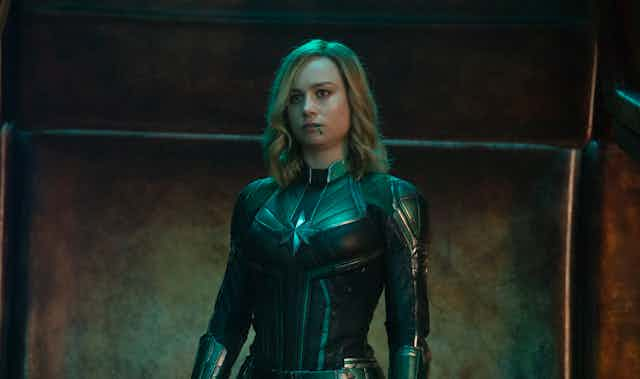The release date of Marvel’s first solo female superhero film was deliberately timed to coincide with International Women’s Day. But is this a celebration of women or a bit of a cynical ploy? International Women’s Day has become something of a media, cultural, and commercial event in recent years. This year, for example, alongside Captain Marvel, soap operas Emmerdale and Neighbours have announced special episodes with all-female cast and crew.
It’s a great marketing strategy, but the line between celebration and cynical cash-in is a fine one. Several commentators have criticised the commodification of IWD and the emphasis on projects such as these media launches over raising awareness of more serious issues affecting women globally.
Focusing the need for greater female visibility (both behind and in front of cameras) around a single day also runs the risk of women’s participation becoming a “special” or unusual event rather than something so equal that it becomes commonplace and unremarkable.
Enter the Captain
Captain Marvel is one of the most-anticipated films of 2019 – and is one of the most established brands in the comics world. Captain Marvel and her alter ego, Carol Danvers, both have long histories within the Marvel Universe (and, indeed, the DC universe, with their version also an alias of the star of forthcoming film Shazam).
Like pretty much everything in comics, it’s complicated. Danvers only assumed the mantle of Captain Marvel – a role that has had several inhabitants, much like Spider-Man – in 2012. The character is a powerful and dynamic one: in the comics she has leadership within the Avengers team, and Marvel boss Kevin Feige has claimed she has the strongest superpowers of all their heroes.
The announcement of a solo Captain Marvel film came in 2014, with Brie Larson attached to the lead role in 2016, closely following her Oscar win for Room. It is common practice for Marvel and Disney to announce films several years before release, but the long wait for a female-led film has angered some fans.
In between the announcement of Captain Marvel and its release, of course, Wonder Woman arrived. The Patty Jenkins film was released to much fanfare and its critical and commercial success was seen as a rare coup for Marvel’s rivals DC, whose recent cinematic outings have generally been regarded as weak.
Interestingly, both franchises have launched with films set in the past: Wonder Woman during World War I and its forthcoming sequel in 1984, and Captain Marvel in the 1990s (allegedly 1995, although there are some anachronistic details in the marketing such as songs on the soundtrack that weren’t released until much later).

These past settings may not just be for plot reasons. Given it has taken embarrassingly long for these female-led superhero films to arrive, it may be no coincidence that neither franchise is set in the present day. It is almost as if the studios are embarrassed of the fact and are trying to retrofit their past so that by the time the series reach the present day, the cinematic universes will have plenty of female superheroes fighting alongside their male counterparts. To launch a Captain Marvel film set in 2019 with her being presented as a “novelty” in a man’s world within the film’s world would seem tone deaf and clumsy (even if that is what’s happening in the “real” 2019).
A cinematic Marvel?
Initial reviews of Captain Marvel have been somewhat mixed – it has received few truly bad reviews, but several highlight flaws in the film. Larson’s performance has been praised, as have the humour and energy of the film. But it’s been criticised for not featuring enough big set-pieces, its narrative focusing too much on an easily resolved mystery, and having a slightly lacklustre plot.
Captain Marvel is hardly the first superhero film to encounter mixed reviews, of course. Its current Metacritic and Rotten Tomatoes scores rate it similarly to Iron Man 2 and 3, Doctor Strange, Avengers: Age of Ultron and both Ant-Man films, and significantly higher than the likes of the Fantastic Four and Hulk.
Even the well-regarded Wonder Woman was not without its problems, including the overemphasis on the love interest, the bloated running time, and the establishment of Diana’s race of fierce Amazonian women warriors at the start – only for them to be sidelined and replaced by an all-male team of laughably bad ethnic stereotypes.
So what might Captain Marvel indicate about the present – and future – of women in film? Within the superhero genre, it’s likely to lead to more. There are strong rumours of a sequel in the works and also murmurs of a Black Widow film. With other popular female comic heroes – such as Ms Marvel – ready and waiting for the big screen, if Captain Marvel proves a success, more will no doubt follow.

But some critics have noted that simply increasing the presence of women in genres such as superhero films is insufficient to address the issues of gender inequality – privileging typically “male” genres, still offering a limited range of female representations, and focusing more on what is on-screen than broader inequalities within the industry where female filmmakers are still a minority.
Having a female-fronted and directed Marvel superhero film is to be celebrated, of course – though its release on IWD may be too cynically opportunistic for some. Hopefully, Captain Marvel will entertain and inspire audiences – men as well as women. But the fact that it is still an exception, rather than the norm, shows us that the film world still has a long way to go before women achieve anything approaching equality.

